British hallmarks on silver
The history of hallmarking in Britain began in the year 1300 in the reign of King Edward the first. It is thus lengthy, and also surprisingly complicated. This short introduction cannot cover all the intricacies; it is intended to be a simple introduction for those with little or no knowledge of the history and practices of hallmarking but are curious about the significance of marks on a piece of silver. Such items will usually be from the nineteenth or early twentieth century, or possibly the eighteenth century, so the emphasis is on helping to identify hallmarks from these periods, including marks that are not hallmarks, and giving some pointers for further research. The word “hallmark” is used in its generally accepted sense as a set of marks required by law.
To receive a hallmark an item must be made of silver of a specified fineness, and must pass a test at an assay office to prove this before it is marked. There are some exceptions to this rule, generally items too small or delicate to bear the hallmarks, such as items of jewellery, although if they are described as silver they must be of legal fineness.
British hallmarks on silver from the period considered usually comprise four or five individual marks.
1. The standard mark
This mark shows that the fineness of the metal meets a specified legal standard. Pure silver is too soft for objects subject to daily wear so it is alloyed with a base metal, usually copper, to make it more durable This dilutes the precious metal and makes the mixture less valuable. Because the proportion of base metal present cannot be readily assessed, the amount allowed to be added is controlled by law. From ancient times coins and silver wares were made from “sterling” silver, which contains not less than eleven ounces and two pennyweights of pure silver in the pound troy, that is at least 925 parts of pure silver in a thousand parts of the metal. Hallmarking was introduced to show that the fineness had been tested and that the base metal content was not more than allowed by law.
The leopard’s head
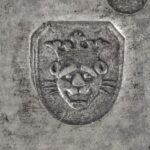 The standard mark decreed in 1300 was the head of a leopard, but which actually looked somewhat like the mark shown here. The head is actually that of a lion, but the mark was called “the leopard’s head” due to a mistranslation of the Norman-French Act, and it has been called the leopard’s head ever since. At first, the leopard’s head was uncrowned, but in 1478, the law was made stricter and a crown was added to distinguish items marked under the new tighter rules. Over time, the mane and beard were removed, and the mark was gradually made to look more like a leopard.
The standard mark decreed in 1300 was the head of a leopard, but which actually looked somewhat like the mark shown here. The head is actually that of a lion, but the mark was called “the leopard’s head” due to a mistranslation of the Norman-French Act, and it has been called the leopard’s head ever since. At first, the leopard’s head was uncrowned, but in 1478, the law was made stricter and a crown was added to distinguish items marked under the new tighter rules. Over time, the mane and beard were removed, and the mark was gradually made to look more like a leopard.
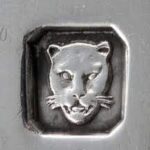 The leopard’s head was first marked by the London Assay Office at Goldsmiths’ Hall, and some books on hallmarking say that it is the town mark of the London Assay Office and shows that items were hallmarked there. However, after 1720, it was also marked by some provincial assay offices in England (see the section “Town mark” below).
The leopard’s head was first marked by the London Assay Office at Goldsmiths’ Hall, and some books on hallmarking say that it is the town mark of the London Assay Office and shows that items were hallmarked there. However, after 1720, it was also marked by some provincial assay offices in England (see the section “Town mark” below).
The leopard’s head marked by the London Assay Office on sterling silver remained crowned until 1821, after that it was uncrowned. The mark here is a leopard’s head struck by the London Assay Office in 1970, and you can see that it looks more like a leopard than the earlier mark. As is often the case, this mark is “rubbed” from polishing, and the original fine detail lost.
The lion passant
During the reign of King Henry VIII, an additional standard mark was introduced in 1544 – the “lion passant”. This is a lion walking across the field of view, with three paws on the ground and right forepaw raised. The lion passant marked by the London Assay Office was initially also “guardant”, his head turned over his shoulder to face the viewer, but after 1821 he faced in the direction he was walking. The lion passant was also marked by provincial assay offices in England after 1720; sometimes passant, sometimes passant guardant. The difference is shown in tables of marks and can be useful in dating an item.
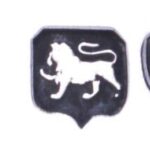 The lion passant became the most widely recognised hallmark symbol because, after 1720, it was used by all of the English assay offices. Although the other marks all varied from place to place depending on which assay office was used, the same lion passant was always present on English sterling silver.
The lion passant became the most widely recognised hallmark symbol because, after 1720, it was used by all of the English assay offices. Although the other marks all varied from place to place depending on which assay office was used, the same lion passant was always present on English sterling silver.
Other assay office standard marks
The standard mark for sterling silver used by the Edinburgh Assay Office was a Scottish thistle, the Glasgow office a lion rampant, and Dublin a harp crowned.
Until the Britannia standard (see below) was introduced, English provincial assay offices used their own marks, which can be found in reference books if you are lucky enough to find a piece of silver from before 1697.
Britannia silver
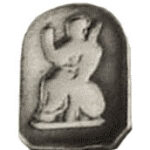 Until the end of the seventeenth century, silver coins and silver wares were all required to be made from sterling silver. In 1697, a higher standard for silver wares was introduced to stop them being made from melted coins. This new standard was not less than eleven ounces and ten pennyweights of pure silver in the pound troy; that is, at least 958.4 parts pure silver in 1000.
Until the end of the seventeenth century, silver coins and silver wares were all required to be made from sterling silver. In 1697, a higher standard for silver wares was introduced to stop them being made from melted coins. This new standard was not less than eleven ounces and ten pennyweights of pure silver in the pound troy; that is, at least 958.4 parts pure silver in 1000.
To indicate the new higher standard, the mark of the leopard’s head was replaced by a lion’s head “erased”, meaning with a jagged neckline, and the lion passant was replace by a figure of Britannia seated. This “new”, or Britannia standard was the only legal standard for silver wares until 1720 when sterling was also allowed again, and the two standards remain legal to this day. This is shown above.
2. Town mark
If an item of silver was hallmarked outside London, the town mark identifies at which office it was marked. The best known of these are:- Chester a sword between three wheatsheaves, Birmingham a ship’s anchor, Sheffield a crown, Edinburgh a three towered castle, Glasgow a tree with a fish, a bird and a bell, and Dublin a seated figure of Hibernia. There were other provincial assay offices in earlier times that had their own distinguishing marks. NB: the assay office where an item was hallmarked may not be where it was actually made.
 The London Assay Office was the only office that didn’t have its own town mark. Until the Britannia standard was introduced, London was the only office that marked the leopard’s head and lion passant on silver. However, the assay offices of Chester, Exeter, Newcastle upon Tyne and York were authorised to strike the new marks of the lions head erased and the figure of Britannia on silver of the new standard. When the old standard was reintroduced in 1720, these offices were also authorised to strike the leopard’s head and lion passant on sterling silver.
The London Assay Office was the only office that didn’t have its own town mark. Until the Britannia standard was introduced, London was the only office that marked the leopard’s head and lion passant on silver. However, the assay offices of Chester, Exeter, Newcastle upon Tyne and York were authorised to strike the new marks of the lions head erased and the figure of Britannia on silver of the new standard. When the old standard was reintroduced in 1720, these offices were also authorised to strike the leopard’s head and lion passant on sterling silver.
The mark of a leopard’s head and lion passant without an additional town mark shows that the item was hallmarked in London, but the leopard’s head and lion passant marks can also be found on silver marked at provincial English assay offices, when they are accompanied by a town mark that shows which office. The set of marks shown here were struck at Newcastle in 1860 or 1861. The leopard’s head is visible below the town mark of three castles of the Newcastle Assay Office.
Along with the lion passant, the leopard’s head was struck by the assay offices of Chester with a crown until 1809 and then without until 1839, Exeter with a crown until 1778, York with a crown until the 1850s and Newcastle with a crown until it closed in 1884. After those dates, these offices struck only the lion passant as the standard mark. The reason why the provincial offices stopped striking the leopard’s head standard mark alongside the lion passant is not known. The Birmingham and Sheffield Assay Offices, authorised in 1773, never struck the leopard’s head mark.
3. Date letter
The date letter was originally introduced in 1478 to show who had been the assayer when a piece was tested and hallmarked. It was changed each year when new wardens were elected, which was part way through the calendar year, and so it can be used to determine the period spanning two calendar years in which the piece was marked. The example shown here is the London date letter for 1895/6. It is important to note that each assay office had its own unique sequences of date letters, and that the assay offices changed their date letters on different dates.
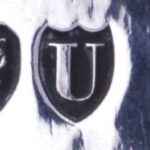 In reading a date letter, both the shape or font of the letter and the shape of the enclosing shield are important. The assay offices changed the fonts and shields for each cycle of date letters so that they were unique, although some letters can still be problematic and other marks or features have to be considered to help reach a conclusion.
In reading a date letter, both the shape or font of the letter and the shape of the enclosing shield are important. The assay offices changed the fonts and shields for each cycle of date letters so that they were unique, although some letters can still be problematic and other marks or features have to be considered to help reach a conclusion.
4. Sponsor’s mark
 Before sending items for hallmarking, a person had to enter their details and a unique punch mark at the assay office. The registered punch mark was impressed onto items before they were sent for assay. The mark originally indicated the master goldsmith in whose workshop the piece was made (Rebecca Emes and Edward Barnard in this example) and became known as the “maker’s mark” although it was never intended for the purpose of identifying who actually made the item. The well known eighteenth century silversmith Paul de Lamerie subcontracted work to other workshops, although striking the finished wares with his own punch, and as trade and manufacturing became more complex, it was recognised that the person who sent an item to be hallmarked might not have been involved in its manufacture but might instead be a retailer or importer. The person submitting an item took responsibility, one of the meanings of the term sponsor, for the fineness of the metal, and bore the penalty if it was found to be substandard, so today the term “sponsor’s mark” is used for this mark.
Before sending items for hallmarking, a person had to enter their details and a unique punch mark at the assay office. The registered punch mark was impressed onto items before they were sent for assay. The mark originally indicated the master goldsmith in whose workshop the piece was made (Rebecca Emes and Edward Barnard in this example) and became known as the “maker’s mark” although it was never intended for the purpose of identifying who actually made the item. The well known eighteenth century silversmith Paul de Lamerie subcontracted work to other workshops, although striking the finished wares with his own punch, and as trade and manufacturing became more complex, it was recognised that the person who sent an item to be hallmarked might not have been involved in its manufacture but might instead be a retailer or importer. The person submitting an item took responsibility, one of the meanings of the term sponsor, for the fineness of the metal, and bore the penalty if it was found to be substandard, so today the term “sponsor’s mark” is used for this mark.
5. Duty mark
In 1784, duty was made payable on silver. This was collected by the assay offices, and a mark of the sovereign’s head stamped to show that it had been paid. Watch cases were made exempt from duty in 1798 and the duty marks shown in tables of hallmarks are not found in watch cases after that date. Duty was abolished altogether in 1890
Hallmarks on imported items
From 1842, imported items should have been assayed in a British assay office and struck with the usual marks, and after 1867, they should also have been given an additional mark of an F in an oval shield, but this was often avoided until the 1883 Revenue Act mandated that all imported silver wares be placed in bond until hallmarked.
In 1904, an Act of Parliament specified that imported gold and silver items hallmarked in British assay offices should have hallmarks that were different from those applied to items made in Britain. Different town marks were specified to be used on imported items, three of which (Phoebus or a sun’s head for London, crossed arrows for Sheffield, and a bishop’s mitre for Glasgow) were soon found to resemble existing trademarks, so in 1906, a revised set of town marks for imported items were specified as shown below.
The traditional standard marks for silver, the leopard’s head and the lion passant, were not used on imported items. The fineness was indicated by the decimal equivalent of the standard in an oval shield, .

925 for sterling and .9584 for Britannia. The date letters remained the same as those used on British made items.
From 1888, imported watch cases should have been marked with combined punches including the word “Foreign”, but this was entirely avoided. Due to an oversight, the 1904 and 1906 legislation did not repeal this requirement and the new import marks were not applied to watch cases until 1 June 1907, when the hallmarking of watch cases was brought into line with that of other imported silver.
Reading a hallmark
If you think a piece might be silver, the first mark to look for is a standard mark – the leopard’s head, lion passant, lion’s head erased, seated figure of Britannia or, for imported items, .925 or .9584 in an oval shield.
Having found a standard mark, next find where the item was assayed. If there is a leopard’s head and lion passant but no separate town mark, you can be sure the item was assayed in London at Goldsmiths’ Hall. Similarly, with the lion’s head erased and the figure of Britannia. If there is a separate town mark, then that tells you where the item was hallmarked; you will need to look it up in a reference book until you are familiar with all the town marks.
Having established in which office the item was hallmarked, you can then turn to the tables of date letters to determine when the item was hallmarked. Look carefully at the shape or font of the letter and the shape of the enclosing shield, as well as the other marks that are present, such as the duty mark, to determine which is the applicable cycle of date letters. The shape of the leopards head, whether it is crowned or has a mane, and whether the lion passant is also guardant, can also provide important clues. This is why each change in these marks is illustrated in the tables.
Marks that look like hallmarks
To give the appearance of solid silver without the cost, first Sheffield plate and then electroplating were devised. Sheffield plate was invented around 1743, made by fusing a sheet of sterling silver to a base or core of copper. Electroplating of silver onto base metal started in Birmingham around 1840 and involves depositing a thin layer of silver onto base metal by electric current.
Neither Sheffield plate or electroplated items will have silver marks. However, they look like silver, because the eye cannot see below the surface. To make them look even more like genuine silver, manufacturers often applied marks that simulated hallmarks. The most frequently encountered of these is “EPNS”, which stands for Electro Plated Nickel Silver, the individual letters sometimes being placed in shields to look like a genuine set of silver marks. Sometimes the manufacturer’s name and some spurious symbols are impressed on an item, again set in shields to look genuine.
Pewter was the most commonly used metalwork for tableware in middle class homes until the arrival of industrial earthenware, porcelain, and glass in the late earthenware in the late 18th Century. Pewter is a tin based alloy that can look very similar to silver when polished, and pewterers often struck imitation silver marks onto their work.
What can be called silver?
Items made of silver do not always have to be fully hallmarked, but to be legally described as silver an item must be made of sterling or Britannia silver. Plated items with a coating of silver over base metal should not be described as silver. If you are told that a testing kit, usually based on acids and reagents, has shown that an item without hallmarks is silver, bear in mind that it might only be silver plated because the fluid can only test the surface layer.
Forged or imitation hallmarks
Hallmarks have sometimes been forged; on rare occasions, they have been cut from small items and soldered onto a larger item (transposed), and correctly marked items have been reshaped into more desirable items (transformed). But the effort involved and the penalties for forgery mean that these crimes are relatively rare. However, it pays to be aware that deceptions have been attempted in the past, and no doubt will be in the future. Caveat emptor.
Further research
The websites of the extant assay offices provide a wealth of information.
London – https://www.assayofficelondon.
Birmingham – www.theassayoffice.co.uk/
Sheffield – www.assayoffice.co.uk/
Edinburgh – www.edinburghassayoffice.co.uk/
Dublin – www.assay.ie/
British Hallmarking Council – https://www.gov.uk/government/
More information on Assay Office marks may be found on www.silvermakersmarks.co.uk/. Another useful site is at www.925-1000.com/. There are also many other sites available by searching online for “Silver hallmarks”.
Selected books
There are many books on silver and hallmarking; here are a few that have been found useful.
Bradbury’s Book of Hallmarks published by the Sheffield Assay Office contains information on hallmarking, tables of date letters for all the assay offices, and slips easily into the pocket. It is inexpensive and a good book to start with.
Jackson’s Silver & Gold Marks of England, Scotland & Ireland Edited by Ian Pickford contains a wealth of detailed information for the more serious collector. There is a pocket version that contains similar information to Bradbury.
Hallmark: A History of the London Assay Office by John Forbes is exactly what it says it is.
Bradbury book of hallmarks Old Sheffield plate register available from – https://www.assayoffice.co.uk/

